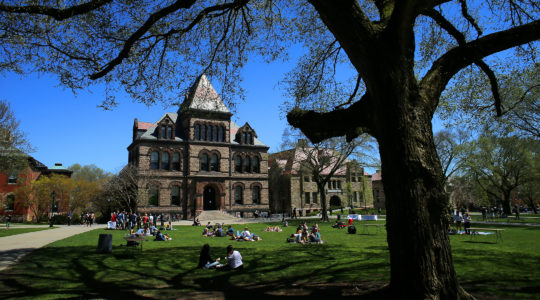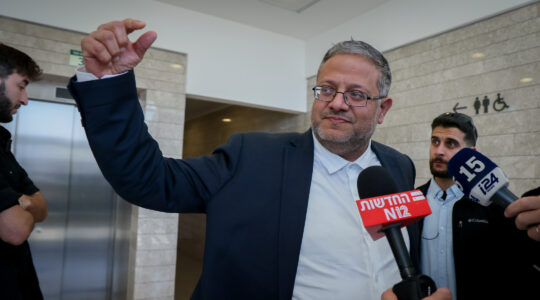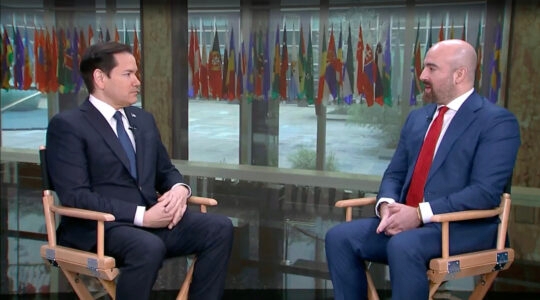NEW YORK (JTA) — When Frank Silberlicht became the executive director of Camp Young Judaea in Wimberley, Texas, in 1998, he had no idea that his job eventually would change from getting a camp up and running to being the CEO of a midsized nonprofit.
But over the past decade or so, as private camps have ramped up their programming and facilities, nonprofit camps like the Young Judaea in Wimberley have realized that they need to do more than just patch up their aging facilities to compete.
In Silberlicht’s case it meant evolving from a situation in which he would reach out to donors whenever something needed repair to creating an active board that raises $500,000 annually for capital improvements and coming up with a strategic plan to boost the camp’s population and facilities.
“No one ever told me about fund raising,” Silberlicht said. “Now that is a big part of my job.”
Young Judaea in Texas is one of 80 not-for-profit camps now working with the Harold Grinspoon Foundation’s Institute for Jewish Philanthropy in a program that offers consulting services to help camp administrators become more professional and millions of dollars in matching grants for improving camps.
The foundation’s benefactor, Harold Grinspoon, was the pioneer in giving Jewish children cash incentives to attend Jewish summer camp, starting a program in 1995 in western Massachusetts that gave scholarships to first-time campers. As that project was picked up by the Foundation for Jewish Camp, which took the initiative nationwide and helped increase the number of Jewish campers to more than 75,000 in 2010, Grinspoon surveyed the camps he was helping to populate and realized that they were in dire need of updating.
His institute deployed a team of consultants and mentors across the United States to work one-on-one with the camps to help them update their fund-raising operations, professionalize their lay leadership boards, initiate strategic plans and improve their fund-raising technology.
For camp administrators, that has meant more successful fund-raising campaigns and more professional management. On the ground, campers are getting better facilities, new sports fields and renovated bunks. That helps increase enrollment, which in turn boosts the camps’ revenue streams and financial viability.
“Jewish overnight camp includes groups that are 100 years old but that had been primarily living off of income [from camp tuition], and with a lot of deferred maintenance,” Eric Phelps, the director of the Institute for Jewish Philanthropy, told JTA. “A camp could be 65 years old and have only 400 people in their database. We have helped them with technology to make sure they have a donor base of more than 6,000.”
Over the past six years the institute has helped camps raise more than $50 million for capital improvements, expansions and endowments, and Grinspoon has pitched in another $10.5 million in matching funds.
Grinspoon also is offering incentives to help camps start to think more seriously about soliciting bequests and legacy grants from donors by offering camps $25,000 in immediate grants over three years if they can meet specific goals for legacy giving. The project thus far has helped 31 camps bring in $31.8 million in legacy gifts.
The Grinspoon Foundation also is working with the Jewish Community Center Association and the Mandel Center of the Jewish Federations of North America to develop a pilot program to bring to day camps the consulting services it has used with overnight camps.
The groups have commissioned a study to be completed by the end of this year to examine the scope of day camps and to help day camps, overnight camps and Jewish community centers work together in mutually beneficial ways.
“They have really been transformed,” said the foundation’s executive director, Joanna Ballantine. “There were facility issues and opportunity issues.”
Or as Phelps put it, “The transformation has been visible and palpable. You wouldn’t recognize some of these camps. It would be like going from Hurricane Katrina to Palm Beach.”
The foundation said it helped one of the smaller camps with which it worked to install donor management software, utilize social media to get guests to its first alumni reunion and raise more than $600,000 in two years — three times its annual operating budget.
Another camp used its Grinspoon mentor to create a strategic plan and a master facilities plan to start a $6 million campaign, of which it already has raised $4.8 million, the foundation said. The camp also has plans to become a green camp, making its facilities, programming and operations environmentally sound.
Camp Ramah of New England has worked with the institute over the past 18 months to help it enact a strategic plan that will make the Conservative camp network become more of a year-round resource to its constituents and potential constituents, board member Aaron Kass said.
“They have really helped focus us and provide us with focus,” Kass said. “They gave us someone who was a fundamentally experienced consultant who was able to walk us through the process of doing this.”
For a camp like Young Judaea in Texas, the transformation started in 2000, when it received an unsolicited $200,000 gift that it had no idea how to handle, Silberlicht recalled. Ultimately the money was used to build an aquatics center and a couple of cabins.
More importantly, however, the gift set off a strategic planning process that has helped the camp grow from 328 campers to nearly 600 and spurred a fund-raising strategy that has raised more than $4 million to start an ambitious building project this year to improve its facilities.
The transformation was accomplished, according to Silberlicht, by revamping the camp’s board, bringing in lay leadership that was active, involved and thinking strategically about raising money.
“They really helped us work those things,” Silberlicht said. “Now board members work in conjunction with the camp director, and it is a team-wide effort.
“We worked on building board relationships, governance and how to recruit people for the board. We learned fund raising — if you bring a donor to the camp, how do you show the camp and make the pitch? Fund raising is not just calling someone and asking for money. You have to get to know donors and communicate with them frequently.”
JTA has documented Jewish history in real-time for over a century. Keep our journalism strong by joining us in supporting independent, award-winning reporting.





